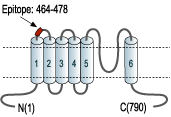Overview
- Peptide (C)REEEAIPHPLALTHK, corresponding to amino acid residues 464-478 of human TRPV3 (Accession Q8NET8). 1st extracellular loop.

- Montell, C. et al. (2002) Mol. Cell. 9, 229.
- Clapham, D.E. (2003) Nature 426, 517.
- Moran, M.M. et al. (2004) Curr. Opin. Neurobiol. 14, 362.
- Clapham, D.E. et al. (2003) Pharmacol. Rev. 55, 591.
- Gunthorpe, M.J. et al. (2002) Trends Pharmacol. Sci. 23, 183.
- Tominaga, M. and Caterina, M.J. (2004) J. Neurobiol. 61, 3.
- Voets, T. et al. (2004) Nature 430, 748.
- Xiao, R. et al. (2008) J. Biol. Chem. 283, 6162.
TRP channels are a large family (about 28 genes) of plasma membrane, non-selective cationic channels that are either specifically or ubiquitously expressed in excitable and non-excitable cells.1 The TRP channels have six putative transmembrane domains (TM) with a pore domain between the fifth and the sixth TM, and all assemble as tetramers. Both the N- and the C-terminus of all TRPs are intracellular.3
According to IUPHAR, the TRP family is composed of three main subfamilies on the basis of sequence homology; TRPC, TRPM and TRPV (to date, three additional subfamilies are also considered to belong to the TRP family: the TRPA, TRPML, and TRPP).1-4 The TRPV subfamily consists of six members, TRPV1-6.5
Four members of the TRPV family have been described as a thermosensitive ion channels (TRPV1 to TRPV4). Each channel exhibits distinct thermal activation thresholds ranging from noxious cold (<17°C) to noxious heat (>52°C).6,7
TRPV3 is highly expressed in skin keratinocytes. It forms a nonselective cation channel that is activated by hot temperatures in the innocuous and noxious range. The channel is also expressed in oral and nasal cavities where it has been postulated to play a role in flavor sensation. TRPV3 is also implicated as a molecular target of some allergens and skin sensitizers.8
Application key:
Species reactivity key:
Anti-TRPV3 (extracellular) Antibody (#ACC-033) is a highly specific antibody directed against an extracellular epitope of human TRPV3. The antibody can be used in western blot, immunohistochemical and immunocytochemical applications. As the antibody recognizes an extracellular epitope, it can be used as a tool to detect TRPV3 in live cells. The antibody has been designed to recognize TRPV3 from human, rat and mouse samples.
Anti-TRPV3 (extracellular)-Biotin Antibody (#ACC-033-B) is directly labeled with biotin. Strepavidin tagged with HRP or with a fluorescent probe can then be used to detect the protein. The biotin/strepavidin system is ideal for minimizing cross-reactivity when same species antibodies are simultaneously used. Anti-TRPV3 (extracellular)-Biotin Antibody has been tested in western blot and live cell imaging and is specially suited to experiments requiring simultaneous labeling of different markers.


